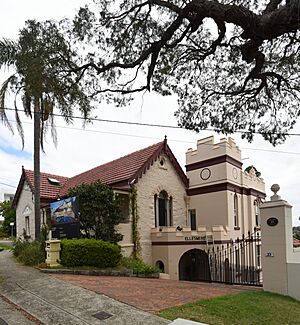Joseph Carruthers facts for kids
Quick facts for kids
Sir Joseph Carruthers
|
|
|---|---|

Carruthers in 1931
|
|
| 16th Premier of New South Wales | |
| In office 29 August 1904 – 1 October 1907 |
|
| Monarch | Edward VII |
| Governor | Sir Harry Rawson |
| Preceded by | Thomas Waddell |
| Succeeded by | Charles Wade |
| Personal details | |
| Born | 21 December 1857 Kiama, New South Wales |
| Died | 10 December 1932 (aged 74) Waverley, Sydney, New South Wales |
| Political party | Liberal and Reform Association |
| Spouses | Louise Marion Roberts m. 1879 dis. 1895 Alice Burnett m. 1898 |
| Children | 4(m), 4(f) |

Sir Joseph Hector McNeil Carruthers (21 December 1857 – 10 December 1932) was an important Australian politician. He served as the Premier of New South Wales from 1904 to 1907.
Carruthers is best known for starting the Liberal and Reform Association. This group was a key step towards the modern Liberal Party of Australia (New South Wales Division). Many people believe he helped shape Australian politics. He moved the liberal ideas to the centre-right side of politics. This influenced both state and national government.
Contents
Sir Joseph Carruthers: A Leader for New South Wales
Early Life and Education
Joseph Carruthers was born in Kiama, New South Wales. His parents were Charlotte Prince and John Carruthers. He went to school in Sydney at William Street National School and Fort Street High School.
Later, he studied at the University of Sydney. He earned a Bachelor of Arts degree in 1876. Two years later, he completed his Master of Arts. He then became a solicitor, which is a type of lawyer.
Starting in Politics
In 1887, Carruthers was elected to the New South Wales Legislative Assembly. This is like the state parliament. He represented the area of Canterbury. He promised to work on local issues, support free trade, and improve society.
He became the Minister of Public Instruction in 1889. This role focused on education. He was very active and especially cared about technical schools. He helped the Ultimo Technical College become very well-known.
Carruthers also played a big part in the Free Trade Party. He helped his friend George Reid become the party leader. In 1894, Carruthers became the Secretary for Lands. He passed an important law in 1895 called the Crown Lands Act. This law helped solve problems between farmers and landowners.
Helping Australia Unite
Carruthers strongly supported the Federation of Australia. This was the process of joining the separate colonies into one country. He believed it was good for the economy and for Australia's future. He also thought it was important for a "White Australia Policy," though he later had doubts about this idea.
In 1897, he was chosen as one of New South Wales' representatives for the Federal convention. He helped write the new Australian Constitution. He worked hard to make sure New South Wales' interests were protected. This included fighting for the state's water rights.
Leading New South Wales
After Federation in 1901, Carruthers became the leader of the New South Wales opposition. He created the Liberal and Reform Association (LRA). This party was different because it had many members and a strong plan.
Carruthers moved the LRA away from old arguments about taxes on goods. He focused on supporting businesses and economic freedom. He wanted clear choices for voters between his party and the Labor Party.
In July 1904, Carruthers' party won the state election. He became the Premier and Treasurer of New South Wales. As Premier, he did excellent work. He managed to reduce taxes and railway costs. At the same time, the state's money situation improved.
His government passed the Local Government Act of 1906. This law created the system of local councils that we still have today. This new level of government was set up without raising taxes too much. He also made more land available for settlement. Work began on the Burrinjuck Dam, which helps with irrigation.
Carruthers and his government did not want Dalgety to be Australia's national capital. They preferred the 'Yass-Canberra' area. Their strong opinion helped lead to Canberra being chosen later.
In 1905, he convinced William Sandford to supply iron and steel to the New South Wales Government. This led to the opening of a blast furnace in Lithgow in 1907. This event marked the beginning of Australia's modern iron and steel industry.
His Later Years and Legacy
In 1905–06, there was an investigation into land matters. Carruthers was questioned, but the investigation found no wrongdoing on his part. He retired from politics temporarily in 1907 due to his health. In 1908, he joined the Legislative Council, which is the upper house of the state parliament.
Even after leaving the top job, Carruthers remained influential. He was very interested in farming and had his own farms. He also helped pass the Sydney Harbour Bridge Bill. He passed away on 10 December 1932.
Carruthers was a very important politician of his time. He helped shape the state's government and its political parties. He also played a role in the Federation of Australia. His work helped create the local government system we use today.
Carruthers had many interests outside of politics. He played cricket and football in his younger days. He was also involved with the New South Wales Cricket Association. He helped set aside a large area as a national park where Captain James Cook first landed in Australia. He also helped get a statue of Captain Cook put up in London.
Honours
Carruthers was made a Knight Commander of the Order of St Michael and St George (KCMG) in 1908. This is a special honour from the British Crown.
Images for kids




